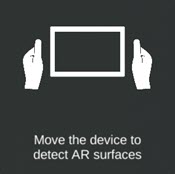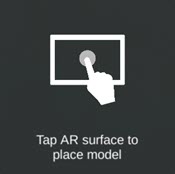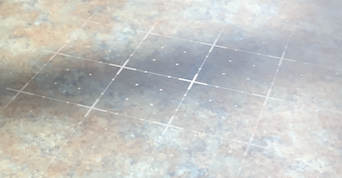This article also applies to the following legacy products:
Pro | Architectural | Suite
QUESTION
I see an AR mode in the 3D Viewer. What is the purpose of this mode?
ANSWER
AR, or Augmented Reality, can be used to help visualize what a digital file or model will look like in a real world environment. In terms of the 3D Viewer, you can place your 3D model onto a real world surface such as a table, and navigate around it. Follow the steps below to learn more about using this mode.
REQUIREMENTS
AR is supported on specific Apple iOS, iPadOS, and Google Android devices. To check to see if your current device is supported, please access the appropriate link below:
To Use the AR Mode
- Open a 3D Model and tap the AR icon
 in the view dock or in the mode section of the view menu.
in the view dock or in the mode section of the view menu.
- A prompt will appear asking you to move the device up, down, left, and right so the app can find eligible horizontal surfaces.

- When an eligible AR surface is detected, the following prompt will appear.

- Tap on the grid once to place the model onto that surface.

- With the model placed, you can navigate around the model, rotate it, make it larger or smaller, and move its location on the real world surface.
- Move around in the real world to view the model.
- Drag left or right with your finger to rotate the model.
- Use two fingers and drag to pan the model.
- Pinch with two fingers to rescale the model.
Tips for Detecting AR Surfaces
If you're having trouble detecting an eligible surface, consider these tips:
- Hold the device at different angles. A steeper angle looking down on a horizontal surface may work better than a shallow angle.
- Walk around the object that you would like to use while pointing the device at it. Standing in one spot may not provide the device enough surfaces to detect.
- AR detects surfaces by identifying "feature points." A "feature point" can be thought of as a distinct character like knots in wood, a pattern or texture, or surface edges.
- Glare can produce false "feature points." Try detecting surfaces with minimal glare.
- Lighting. It's important that the surface you're wanting to use has enough light surrounding it. If the area is too dark, the surface may not be detected by the device.
- Switch view modes. If you notice that the AR mode is not detecting any eligible surfaces, it may be worth switching to a different mode temporarily and then switching back to the AR mode.
If you continue to experience problems with detecting eligible surfaces, and your device meets the requirements for AR, feel free to print a marker image and place it on the surface that you would like to use. Hover the device over the printed marker so it has an unobstructed view and fills at least 25% of your device's screen. When the device detects the image, it will place the model on top of the marker.


